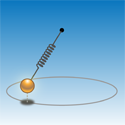Swinging and springing
When a spherical pendulum is vertically upside down, even a tiny deviation will kick it out of position. This type of unstable point in a mechanical system corresponds to a singularity in the constants of motion.
Mathematicians call the study of a system as it loops around such a singularity “monodromy,” which literally means “once around.” While the effects of monodromy should appear both in classical systems, such as pendulums and spinning tops, and quantum systems, such as rotating molecules, they have only been observed experimentally (and rarely) in a quantum system. Writing in Physical Review Letters, Noah Fitch and colleagues at JILA and the University of Colorado, US, in collaboration with the University of Sydney, Australia, present the first experimental demonstration of monodromy in a classical system.
They consider the case of a three-dimensional elastic pendulum, where the pendulum swings on a pivot and the arm of the pendulum is a spring. For the special case that the springing fundamental frequency is twice that of the swinging frequency, the pendulum oscillates between pure swinging motion and pure springing motion, with the mass tracing out an ellipse when it is purely swinging about the pivot.
The ellipse precesses in a stepwise fashion with each cycle of pure swinging motion. In particular, if the group arranges sets of initial conditions that either avoid the singularity or loop around it, the stepwise precession angle will either return to its initial value or not. The latter is a direct physical consequence of monodromy.
The elastic pendulum has a quantum analogue in triatomic molecules, such as CO2, where the bending of the molecule is like the pendulum’s swinging motion and the stretching of the molecular bonds is like its springing motion. The measurements by Fitch et al. could therefore provide intuition for quantum systems, where monodromy disrupts a simple quantization of the energy eigenstates. – Jessica Thomas





